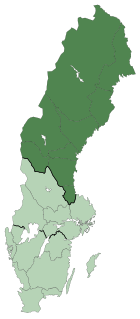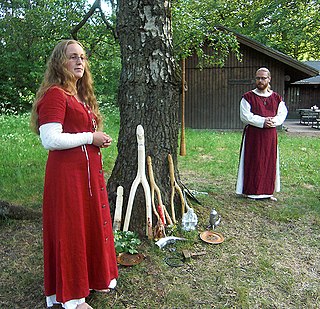
Västernorrland County is a county (län) in the north of Sweden. It is bordered by the counties of Gävleborg, Jämtland, Västerbotten and the Gulf of Bothnia.

Norrland is the northernmost, largest and least populated of the three traditional lands of Sweden, consisting of nine provinces. The term Norrland is not used for any administrative purpose, but as a historical region, it is common in everyday language, e.g., in weather forecasts.
The Swedish alphabet is a basic element of the writing system used for the Swedish language. The 29 letters of this alphabet are the modern 26-letter basic Latin alphabet plus 'Å', 'Ä', and 'Ö', in that order. It contains 20 consonants and 9 vowels.

The Swedish-speaking population of Finland is a linguistic minority in Finland. They maintain a strong identity and are seen either as a separate ethnic group, while still being Finns, or as a distinct nationality. They speak Finland Swedish, which encompasses both a standard language and distinct dialects that are mutually intelligible with the dialects spoken in Sweden and, to a lesser extent, other Scandinavian languages.

Frösöstenen is the northern-most raised runestone in the World and Jämtland's only runestone. It originally stood at the tip of ferry terminal on the sound between the island of Frösön and Östersund.
Social welfare in Sweden is made up of several organizations and systems dealing with welfare. It is mostly funded by taxes, and executed by the public sector on all levels of government as well as private organizations. It can be separated into three parts falling under three different ministries. Social welfare is the responsibility of the Ministry of Health and Social Affairs. Education is the responsibility of the Ministry of Education and Research. The labour market is the responsibility of the Ministry of Employment.

The Swedish Forn Sed Assembly, formerly Swedish Asatru Assembly is a heathen organization founded in 1994.

Håkan Juholt is a Swedish politician who was Leader of the Social Democrats from 2011 to 2012. He was member of the Swedish parliament from 1994 to 2016, representing Kalmar län. Juholt serves as Sweden's Ambassador to the Republic of Iceland since September 2017.

Inga-Britt Monica Stigsdotter Ahlenius is a Swedish auditor, public servant and former Under-Secretary-General for the United Nations Office of Internal Oversight Services (OIOS).
The history of Jämtland dates back thousands of years, starting with the arrival of humans. As the population grew larger and started to settle down Jämtland was turned into an autonomous peasant republic, with its own law, currency and parliament. Jämtland was conquered by Norway in 1178 and stayed Norwegian for over 450 years and maintained some autonomy until it was ceded to Sweden in 1645. The province has since been Swedish for roughly 350 years, though the population did not gain Swedish citizenship until 1699.
Swedish folk music is a genre of music based largely on folkloric collection work that began in the early 19th century in Sweden. The primary instrument of Swedish folk music is the fiddle. Another common instrument, unique to Swedish traditions, is the nyckelharpa. Most Swedish instrumental folk music is dance music; the signature music and dance form within Swedish folk music is the polska. Vocal and instrumental traditions in Sweden have tended to share tunes historically, though they have been performed separately. Beginning with the folk music revival of the 1970s, vocalists and instrumentalists have also begun to perform together in folk music ensembles.
Monica Kristina Ingeborg Törnell, is a Swedish singer and songwriter. After being discovered by Cornelis Vreeswijk 1971, she was a prominent singer in several genres, mainly folk and rock music, for over two decades. Together with Lasse Holm, she represented Sweden in the Eurovision Song Contest 1986 in Bergen, Norway. She is the mother of Tobias and Mattias Törnell.
A number of internment camps were operated by Sweden during World War II. These camps were used for internment of, among others, suspected criminals, German refugees, anarchists and Swedish communists.
Konsthistorisk tidskrift is a quarterly peer-reviewed Swedish academic journal on art history that was established in 1932 by Konsthistoriska sällskapet in Stockholm. The journal was published until 1967 under the full title Konsthistorisk tidskrift: revy för konst och konstforskning. Since 2002 it has carried the English alternate title Journal of Art History. It was published by the Scandinavian University Press from 1992 till 1999, and has been published by Routledge since 2000.

Gottfrid Larsson (1875–1947), born November 21, 1875 in Vallerstad in Östergötland, Sweden, died December 24, 1947 in Stockholm, Sweden, was a Swedish sculptor.
Margareta Biörnstad, is a Swedish archaeologist. She was Sweden's first female National Antiquarian (riksantikvarie) in 1987–93.
Curtis Edwards is an English footballer who plays for Östersunds FK as a midfielder.

Karl Ewert Alvar Ljusberg, born 7 May 1945 in Hede, Härjedalen, is a Swedish troubadour, ballad singer, entertainer, and the fictitious Republic of Jamtlands president since the year 1989. He lives in Hällekis.


















